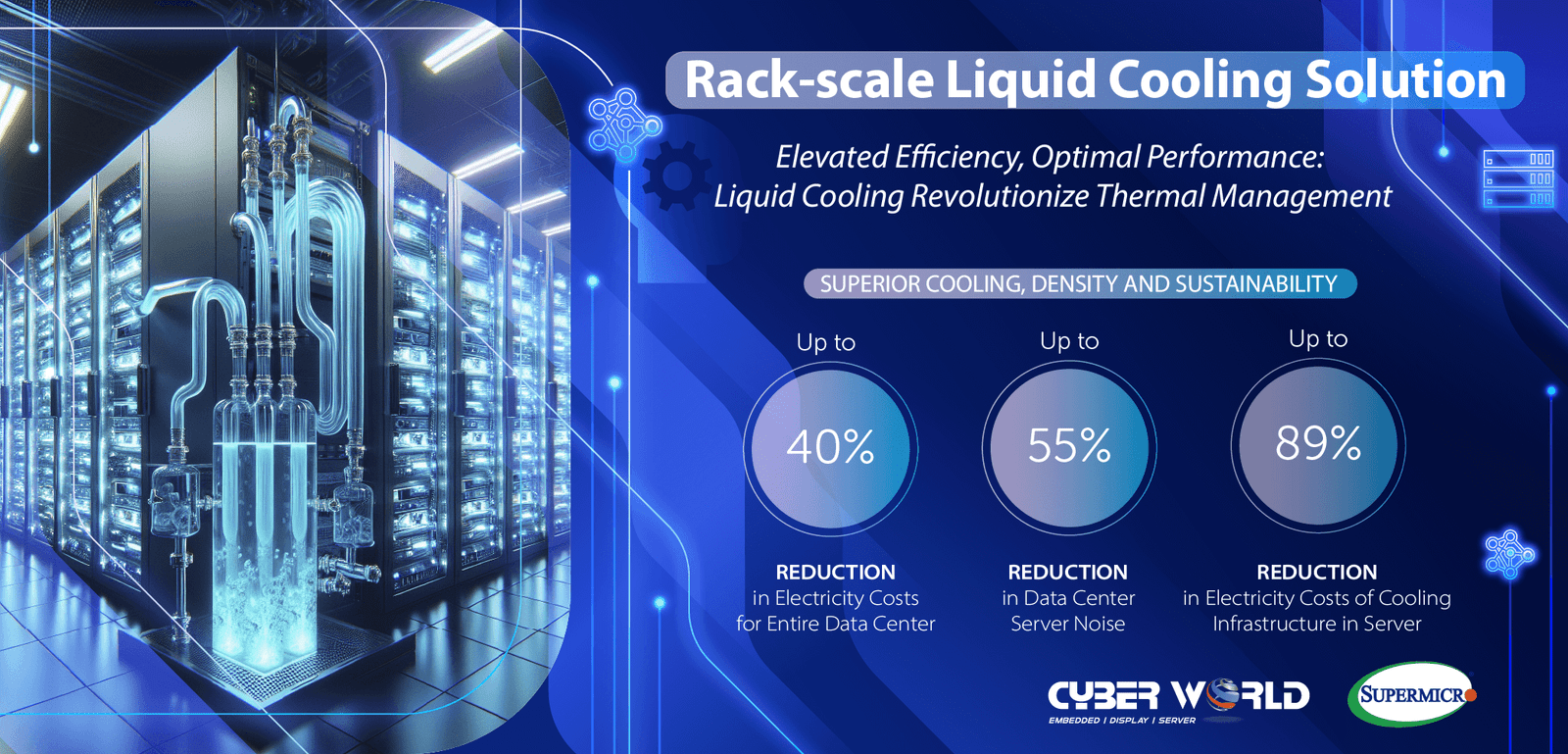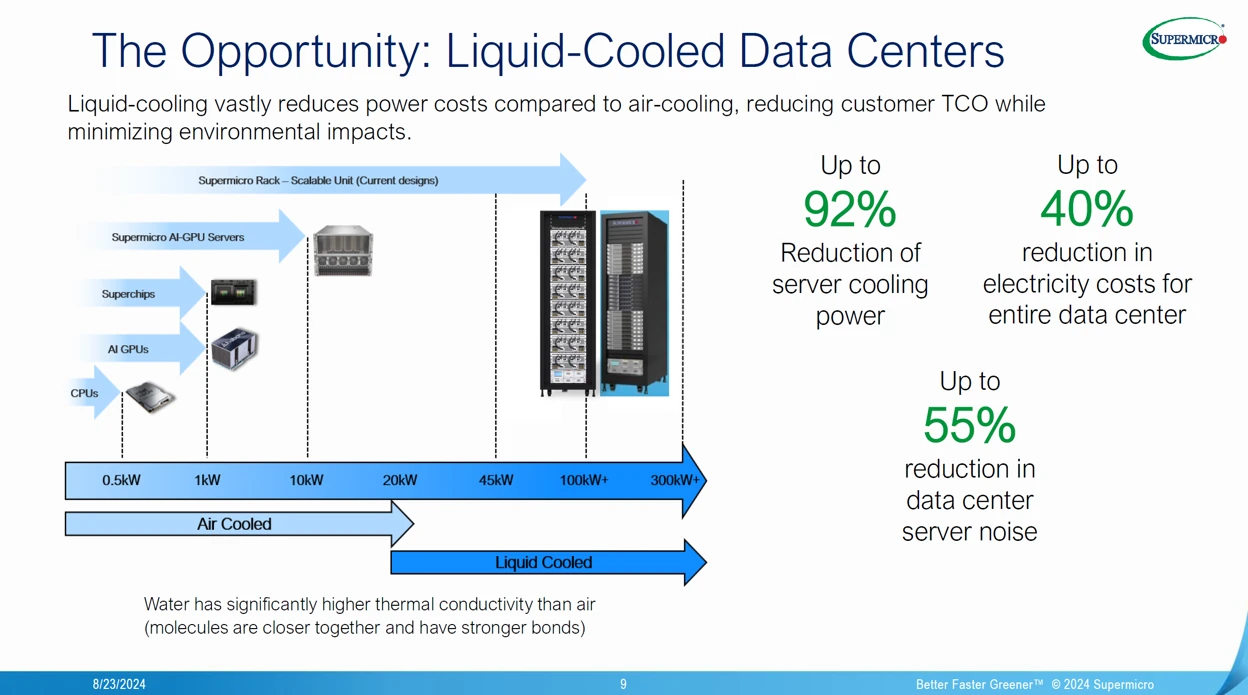Overview
Enhanced Cooling Solutions for Modern Data Centers
Supermicro’s advanced DLC-2 technology introduces a next-generation cooling system that can reduce data center power usage by up to 40%. This improvement is achieved through direct-to-chip liquid cooling, which efficiently lowers the ambient cooling needs of servers. The design incorporates cold plates for CPUs, GPUs, and other critical components, allowing hardware to operate at higher inlet temperatures of up to 45°C. By limiting or eliminating dependence on traditional chillers, this system also reduces overall water usage by approximately 40%.

With this new system, noise levels in data centers drop significantly, maintaining quieter operations at around 50dB. The implementation combines lower fan speeds with fewer fans overall, which is made possible by near-complete heat capture through the liquid-cooling architecture. Furthermore, this approach results in increased floor space savings since the hardware requires less infrastructure to manage heat effectively.
Super Micro Computer, Inc. OverviewOptimized Systems for AI and High-Performance Computing (HPC)
At the heart of Supermicro’s DLC-2 solution is a GPU-optimized server, featuring eight NVIDIA GB200 GPUs paired with dual Intel Xeon 6 CPUs in a compact 4U rack design. This setup balances powerful computation with efficient cooling, making it ideal for AI-driven workloads, enterprise-level cloud services, and edge computing applications. The inclusion of direct cooling for GPUs using cold plates further enhances thermal performance, boosting AI processing per watt.
In addition, vertical coolant distribution manifolds (CDMs) contribute to the system’s ability to remove heat efficiently. The innovation ensures an even flow of coolant throughout the rack while optimizing the rack’s overall capacity, capable of dissipating up to 250kW of heat per rack. This capability supports more compute nodes per square foot, improving data center density and maximizing productivity.
Comprehensive Architectural Design
Supermicro’s DLC-2 is more than just a cooling solution; it represents a holistic redesign of hardware architecture tailored for modern workloads. The building block approach allows customers to customize systems based on their specific needs. Components like server building block solutions, modular cooling elements, and integrated software tools work seamlessly together to deliver exceptional performance. Through streamlined liquid distribution and reduced reliance on rear-door heat exchangers, cooling costs for enterprises drop dramatically, resulting in lower total cost of ownership (TCO) by as much as 20%.
The system is purpose-built for integration with Supermicro’s SuperCloud Composer software suite, which simplifies data center management and monitoring. This full-stack solution ensures end-to-end compatibility while reducing deployment time for IT infrastructure, from cloud systems to IoT networks.
Green Computing and Sustainability Initiatives
Supermicro’s commitment to green computing extends through the DLC-2 platform. By enabling higher inlet temperatures and removing reliance on energy-intensive chillers, the energy footprint of data centers decreases substantially. Hybrid cooling towers and other innovative features further enhance efficiency, adapting to diverse climate conditions and seasonal changes.

The architecture also minimizes water consumption, making it a viable option for data centers in regions with water scarcity. This strategy aligns with the company’s vision to embrace environmentally-friendly practices while supporting industries like 5G telecommunications, storage management, and cloud computing.
Application-Optimized Systems
True to its role as a total IT solutions provider, Supermicro integrates its DLC-2 systems with a range of application-optimized solutions. Their product portfolio spans industries including enterprise IT, edge computing, and other high-demand environments that often require consistent, reliable performance. For businesses operating in AI/ML, storage solutions, or switch systems, the flexible options offered by Supermicro are designed to scale as needed.
By implementing modular compute and storage designs alongside cutting-edge cooling systems, organizations benefit from reduced operational costs and improved hardware longevity. This adaptability is particularly valuable in dynamic sectors like cloud hosting and IoT ecosystems, where efficient resource use is key.
Scalable and Reliable Infrastructure
Global infrastructure challenges require scalable solutions, and Supermicro’s vertically integrated manufacturing meets this demand. The DLC-2 architecture is backed by global production facilities in the US, Europe, and Asia, ensuring timely deliveries and dependable quality. Through scalable deployment offerings, from in-rack liquid cooling to full-scale data center building block solutions, enterprises can use their resources more efficiently.
These systems are fully validated for real-world applications, supported by on-site deployment services, professional maintenance, and continuing updates in design to stay ahead of IT demands. This cohesive setup makes Supermicro a leader in building robust and reliable IT ecosystems across a diverse range of industries.
Frequently Asked Questions

How does liquid cooling technology improve data center efficiency?
Direct liquid cooling transfers heat more effectively than traditional air-cooling methods. By circulating liquid directly to key components, such as CPUs and GPUs, it reduces the dependency on fans and air conditioning systems. This approach helps optimize thermal management while minimizing energy losses.
What are the key advantages of Supermicro’s DLC-2 solutions in performance?
The DLC-2 solutions from Supermicro are designed to significantly reduce power usage by up to 40% when compared to conventional air-cooling systems. They also aim to enhance system stability and scalability while lowering the total cost of ownership. Additionally, these solutions can improve system reliability by keeping hardware at optimal temperatures.
What components are commonly included in a liquid cooling setup?

A typical direct liquid cooling system includes chillers, cold plates, connectors, tubing, pumps, and heat exchangers. These components work together to transfer heat away from critical components, such as processors and memory, ensuring consistent cooling performance.
Can Supermicro’s DLC-2 be integrated with existing data center setups?
The DLC-2 solutions are designed with compatibility in mind, enabling seamless integration with many existing data center systems. Their modular design allows data center operators to deploy the technology without requiring a complete overhaul of the infrastructure.
How do DLC-2 solutions affect the energy consumption of a data center?
By eliminating the need for high-energy air conditioning and reducing fan usage, DLC-2 solutions can cut overall power consumption by a substantial margin. These efficiencies help reduce operating costs and environmental impact, making data centers more sustainable.
What are the maintenance requirements for Supermicro’s DLC-2 cooling systems?
Maintenance for liquid cooling setups includes monitoring and managing coolant levels, inspecting connections for leaks, and ensuring pumps and other components function properly. Regular system checks are essential to maintain efficiency and prevent potential failures.





































